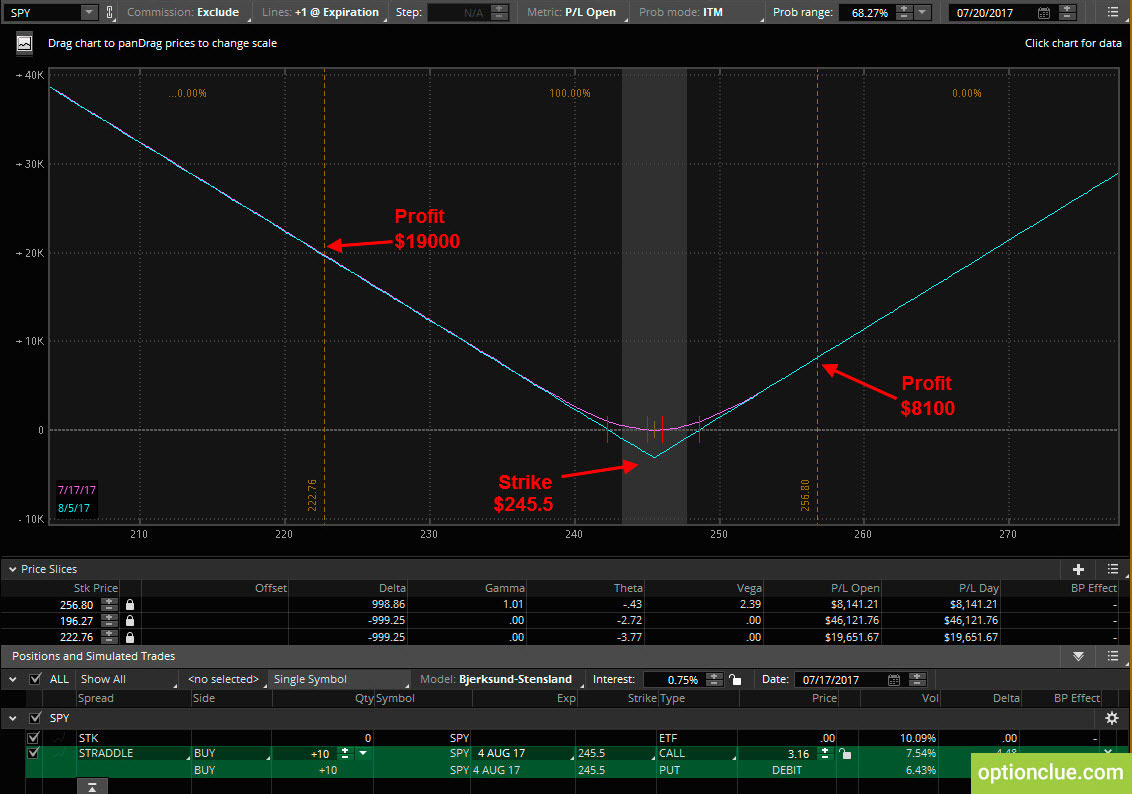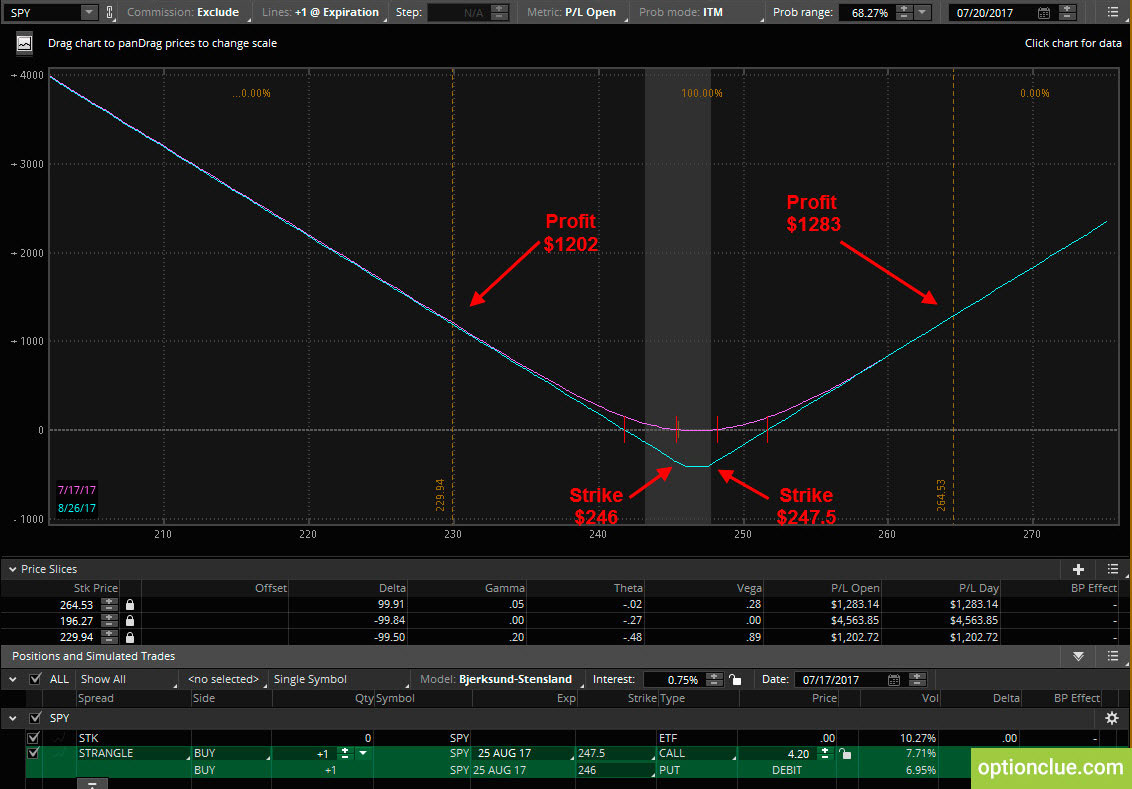Best Stock Options to Buy Now. Long Straddle and Strangle.

Choosing of assets for trading can take a long time, especially when it comes to options trading. Keeping this in mind, we’ve created the options screener that saves your time and helps find new trading ideas based on a simple principle – buying cheap options or selling expensive ones.
In this article we’ll discuss one of the most popular options of using option strategies which are called long straddle option and long strangle. These strategies have already proved their effectiveness and are actively used by both novice and experienced traders.
Contents
- Introduction to straddle and strangle
- Long Straddle
- Long Strangle
- Conclusions on long straddle and strangle options
Introduction to Straddle and Strangle
As you know, any strategy based on a single option is designed to generate profit from the unidirectional underlying asset price movement. For example, buying a call option will give a positive financial result from an increase in the price of the underlying asset, and a long put option will benefit from decline in prices.
However, there are often situations in the market when you can expect the price development in any direction. This is often observed at times of real possibility of breaking through the existing price range (a flat or a triangle – that is, the market condition when the classic trading is not possible or too risky). Here you can find more information about trend screener.
In this case, strategies, based on the simultaneous purchase of call and put options, can help us, that is, in other words, an investor occupies the position in the market simultaneously in two directions: up and down. A strategy that uses call and put options with different strike prices is called long strangle. If the strikes are the same, then we are talking about the long straddle.
Long Straddle
Typically, long straddle is usually formed by at-the-money options, since the existence of a fairly narrow price range in the market at the time of applying this option strategy makes it possible, due to increased volatility in a short period of time, to enable one of the option contracts to become in-the-money. Other options for creating a long straddle will be ineffective, so we will not consider their actual use.
Therefore, we can say long straddle is the option strategy based on volatility which lies in the simultaneous buying call and put options on one asset with the same strikes.
The profit and loss graph (Fig. 1) provides insight into the long straddle and indicates the benefit possibilities from the strategy application. For the strategy presented, the call and put options on SPY calculated on July the 20-th with a strike price of $245.5 and the expiration date on August the 4-th were used. As you can see on the chart, the cost of the long straddle is $316 or $3160 for 10 contracts. It contains the same number of each type of the options – a call and a put.
According to the current market situation and evaluating the long straddle chart, you can assess the prospects for success in case of buying this option strategy. The most important thing is the options analysis (analysis of potential risk and break-even points). Overall risk is determined as all money loss invested in the purchase of a straddle. The amount of premiums paid at the time of buying call and put options reflects the maximum risk of the strategy. The break-even point is related to the strike price of put and call options, as well as the risk, and since there are two of them, they are determined by adding or subtracting the risk from the options exercise price.
In our case:
- Break-even point 1 = $245.5 + $3.16 = $248.66
- Break-even point 2 = $245.5 – $3.16 = $242.34
Now let’s analyze the more pleasant part of the chart for an investor and consider how he acts when reaching break-even points. If the price of the underlying asset increases and reaches the level of $248.66, then, beginning from this point, further increase in price of the asset will significantly increase the option price. The asset price of $256 marked on the chart with a vertical line will gain $8,100 to the option holder. If the market declines and falls below the break-even point at $242.34 and reaches the price mark of $222 (marked by a vertical line), then this option will benefit $19,000 to the investor.
Apart from the simultaneous purchase of the same number of call and put options, an investor can also contribute the probability factor with a more likely price range breakout in any direction. For this purpose, he can buy, for example, 2 calls and 1 put, thereby in case of market upward movement the profit will increase. Such use of the strategy is common for gambling people, so at first I recommend to master the classic option of a long straddle.
Long Strangle
Long strangle is a related strategy to long straddle, the main difference of which is that it is based on call and put options with different exercise prices, and, as a rule, these options are out-of-the-money. A long strangle is highly dependent on market volatility and this strategy is generally used at the time of minimum liquidity which makes it possible, at first, to get adequate price when buying the contract and, secondly, to expect a rapid market movement after flats or triangles breakout.
Long strangle is the option strategy with limited risk, based on volatility, which lies in the simultaneous buying of calls and puts on one asset with higher/lower strikes respectively.
The profit and loss graph (Fig. 2) provides insight into the long strangle and indicates the benefit possibilities from the strategy application. For the strategy presented, the call and put options on SPY calculated on July the 20-th with the expiration date on August the 25-th were used. Strike prices are $247.5 and $246.
As you see on the chart, the cost of the long strangle is 4.20 or $420 ($4.20 * 100); it contains the same number of option contracts of each type – call and put.
By analogy with the long straddle, let’s consider the main features of this trading strategy based on the graph. Each responsible trader when opening a position in the market (for exmaple, selling and purchasing stock options) first of all should assess risks he takes in a particular situation. In our case, the maximum risk is limited to the sum of option premiums when buying the strangle, that is $420.
In other words, if the market, contrary to expectations, remains in a narrow price range until the end of the option’s lifetime, then such purchase does not justify itself, and the investor suffers losses that are equal to the premium. There are 2 break-even points in this strategy, as well as in the straddle example, and they also depend on the options exercise prices and the option premium.
In our case:
- Break-even point 1 = $247.5 + $4.20 = $251.7
- Break-even point 2 = $247.5 – $4.20 = $241.8
Now we can assess the price range from $241.8 to $251.7 and analyze the market movement potential beyond these marks in a strictly limited period of time (time to expiration date). If you see that the price can go beyond these price levels, then the long strangle is justified and one can use this strategy without any doubt.
If the upper border of the allocated price range is broken through and the price rushes above the break-even point at $251.7, then the option price increases aggressively. The level of $264 marked on the graph with a vertical line will give the option buyer $1283, if exercised. During the market decline and after overcoming the second break-even point at $241.8 the contract price will also increase and will gain $1202 to the option holder when reaching the price mark of $229.
As you can see from the example above, in case of a favorable development, the profit will be about $1200, at the same time the maximum possible loss is $400, which indicates a sufficient risk-reward ratio (1:3), that should be at least 1:2 and lower. Therefore, if the market movement to the marks of $264 or $229 is predictable and does not contradict the nearest price levels of the Daily timeframe, one can purchase this strategy with the appropriate parameters and expect a positive financial result which corresponds to the rules of risk-management.
Conclusions on Long Straddle and Strangle Options
Long straddle and long strangle option strategies give a trader an opportunity to earn in situations that can probably lead to a rapid market movement in any direction. The simultaneous purchase of put and call options makes the strategy immune to false determination of the market movement direction – up or down, and the strategy gains profit anyway. The only risk is that until a certain date the price goes beyond the strategy break-even points, otherwise an investor will suffer losses.
Proceeding from the above, we can emphasize the particular aspects of these strategies implementation:
- It’s necessary to buy straddle or strangle when both market volatility and options implied volatility are low
- The most promising period for the strategy formation is the approach of key support and resistance levels breakout in any direction
Therefore, a trader needs to check the price of the underlying asset for the flat and triangle occurrence – the precursors to the rapid market movement after leaving the price range, and analyze the costs of buying the corresponding call and put options since the main disadvantage of these strategies is their relatively high cost.
After reading this article you’ll be able to choose best stock options to buy today in order to run long straddles and strangles.


